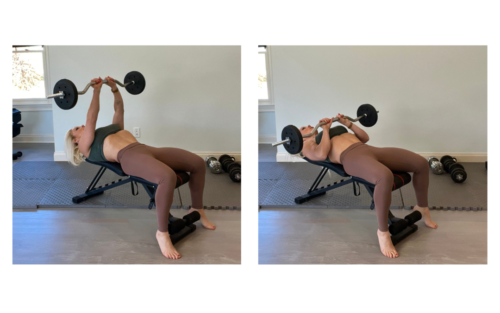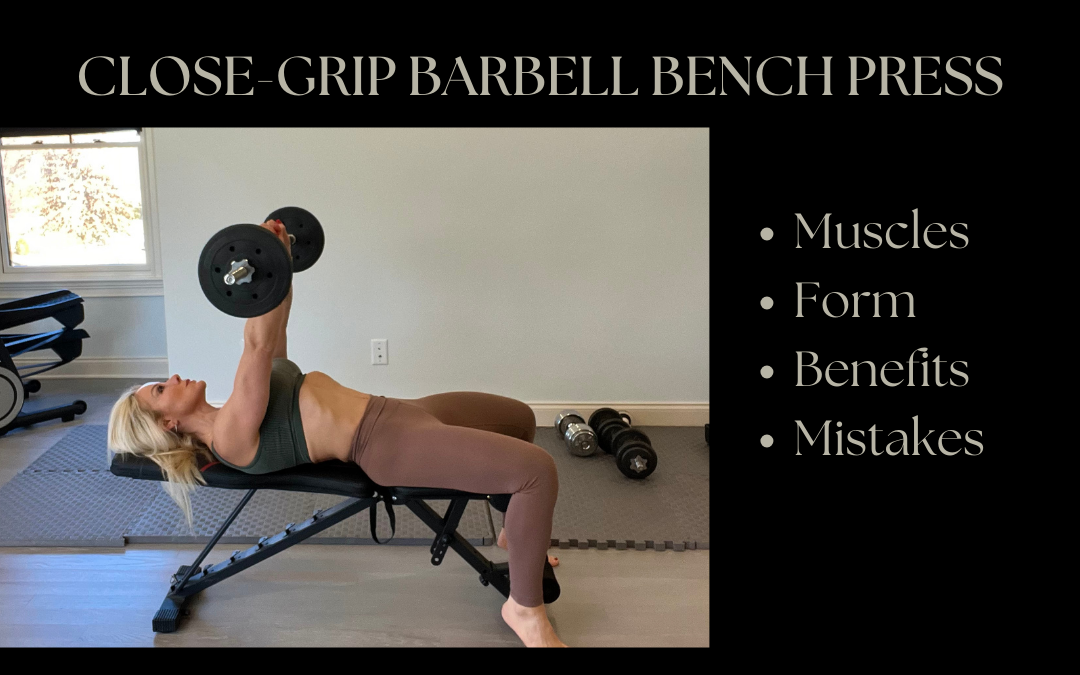Working out the chest helps strengthen and develop the upper body. A strong chest improves your ability to perform daily tasks involved in such as pushing, lifting, and carrying objects. If you want to add variety to your chest workout, incorporate close-grip barbell bench presses. This guide will teach you the muscles involved in close-grip barbell bench presses, the benefits and common mistakes associated with this exercise, how to perform the close-grip barbell bench press properly, and give you ideas to complete your chest workout.
The close grip bench press is a variation of the traditional bench press that involves using a narrower grip. The close-grip bench press is often used as an accessory exercise to target the triceps and the inner part of the chest more directly compared to the traditional bench press with a wider grip.
What Muscles Does the Close-Grip Barbell Bench Press Work?
Here are all the muscles involved in the exercise:
Primary Muscles:
- Pectoral Muscles: These muscles are located in the chest area pectorals, consisting of the pectoralis major and pectoralis minor. The pectoralis major is the larger muscle, shaped like a fan, comprising most of the chest wall. It keeps your arms attached to your body and is involved in adduction and internal rotation of the arm on the shoulder joint, as well as flapping, pressing, and lifting movements. The pectoralis minor is smaller and flatter and lies underneath the pectoralis major. It is involved in shoulder functioning. The close-grip bench press still targets the chest muscles, but the emphasis shifts towards the inner part of the chest.
- Triceps Brachii: These muscles are located on the back of the upper arm. Their name is an indication of the three muscle strands (the long, medial, and lateral heads) that compose this area. The triceps are involved in forearm and elbow extension, extending or straightening the elbow. They are also involved in stabilizing the shoulder joint, as well as shoulder adduction and extension. The triceps are heavily involved in the close-grip bench press, as the hand positioning places greater stress on the triceps – and even higher emphasis on the long head of the triceps.
- Deltoids: These main shoulder muscles are activated during this exercise. The most engaged deltoids here are the anterior deltoids. They help flex and medially rotate the arm and much more in an incline position.
- Trapezius: These muscles are shaped like a diamond and extend from the top of the neck to the shoulder and down toward the mid-back. They attach to the skull, vertebral column, and shoulder girdle. The traps are involved, especially during the stabilization phase of the lift.
- Rhomboids: These muscles are located between the shoulder blades. They are engaged during this exercise as they stabilize the scapulae (shoulder blades), working as stabilizers.
Secondary muscles:
- Deltoids: These main shoulder muscles are activated during this exercise. The most engaged deltoids here are the anterior deltoids. They help flex and medially rotate the arm and much more in an incline position.
- Trapezius: These muscles are shaped like a diamond and extend from the top of the neck to the shoulder and down toward the mid-back. They attach to the skull, vertebral column, and shoulder girdle. The traps are involved, especially during the stabilization phase of the lift.
- Rhomboids: These muscles are located between the shoulder blades. They are engaged during this exercise as they stabilize the scapulae (shoulder blades), working as stabilizers.
Close-Grip Barbell Bench Press Benefits
After learning the muscles involved in close-grip chest presses, let’s look at the vast benefits associated with the exercise:
- Triceps Emphasis & Strength: The close grip bench press places greater emphasis on the triceps compared to a regular grip bench press. This is because the closer hand positioning reduces the involvement of the chest muscles, shifting more of the workload to the triceps. Since the triceps are being assisted by the chest and shoulders, you can lift heavier loads than with any other exercise for the triceps.
- Upper Body Strength: This exercise strengthens your chest muscles as well as multiple upper body areas. It intensely trains the triceps since it enhances your ability to finish the lift at the top portion of the movement.
- Reduced Shoulder Stress: Wider grip bench presses can sometimes place too much stress on the shoulder joints but the close grip can be gentler on the shoulders for some people. This grip may help alleviate this stress by allowing a more natural range of motion.
- Muscle Engagement: While the primary focus is on the triceps, close grip bench presses still engage the chest and shoulders to some extent, providing a more comprehensive upper body workout.
- Versatility: Close grip bench presses can be easily integrated into various training programs, whether you’re focusing on strength, hypertrophy, or endurance. They can be used as a primary triceps exercise or as an accessory movement to complement your bench press routine.
- Calorie Burner: Since this is a multi-joint exercise encompassing multiple upper body muscles, it helps you burn more calories and consequently more body fat.
- Aesthetics: This exercise helps mold a great upper body. It helps lift the chest and sculpt the triceps and shoulders.
- Simplicity: Close grip bench presses can be performed by anyone, at any age, or any fitness level. The only equipment needed is a bench and a barbell. But if you don’t have a bench, you can even perform the exercise on the floor.
How to do Close-Grip Barbell Bench Press
- Lie down on a flat bench with your back flat against the bench.
- Grab the barbell with your hands closer together than shoulder-width apart. You can place your hands about 8 to 12 inches apart, or even closer if you want to engage your triceps even more. Adjust the grip based on your comfort and shoulder flexibility.
- Make sure your wrists are straight and the bar is directly over your lower chest.
- Plant your feet firmly on the ground and engage your core for stability.
- Keep your elbows close to your body throughout the movement. This is another factor that distinguishes the close-grip bench press from the traditional bench press. They can point back at about a 45-degree angle from your torso.
- As you inhale, lower the barbell slowly and under control, keeping it in line with your lower chest.
- Aim to bring the bar down to the bottom of your sternum.
- As you exhale, push the barbell back up to the starting position using the triceps.
- Keep the movement controlled and avoid locking out your elbows at the top to maintain tension on the triceps.
- Perform the desired number of repetitions, maintaining proper form.

Close-Grip Barbell Bench Press Mistakes
While it can be an effective exercise for targeting the triceps and inner chest, there are common mistakes that people make when performing close-grip bench presses. Here are some of them:
- Incorrect hand placement: One of the key aspects of the close grip bench press is hand placement. If your hands are too far apart, it can affect the muscles targeted and increase the risk of injury. A good guideline is to have your hands positioned inside shoulder-width.
- Locking Your Elbows: Locking your elbows at the top or extending them explosively can increase your risk of injuring your elbows or shoulder joints.
- Flaring elbows: Allowing your elbows to flare out to the sides excessively can put unnecessary stress on the shoulder joints. Keep your elbows close to your body throughout the movement to engage the triceps and protect your shoulders.
- Lack of control: Some lifters may use excessive momentum or bounce the bar off their chest during close-grip bench presses. This not only reduces the effectiveness of the exercise but also increases the risk of injury. Focus on controlled movements, both on the way down and on the way up.
- Neglecting proper warm-up: It’s essential to warm up adequately before engaging in any weightlifting exercise. Proper warm-up helps increase blood flow to the muscles, improves flexibility, and reduces the risk of injury.
- Using too much weight: As with any exercise, using excessive weight can compromise your form and increase your risk of injury. Start with a lighter weight to ensure proper form before progressing to heavier loads as your strength improves.
- Not engaging the core: Neglecting to engage your core during the exercise can lead to instability and may even cause lower back discomfort. Keep your core tight throughout the movement to provide stability and protect your spine.
- Ignoring pain or discomfort: If you experience pain or discomfort at any point during the movement, it’s important to address it. Ignoring pain can lead to a serious injury. If you consistently experience pain, consider consulting with a fitness professional or healthcare provider to assess your form and technique.
Always prioritize proper form, ensure that the weight is manageable to avoid unnecessary strain on the wrists, elbows, and shoulders, and make adjustments as needed to ensure a safe and effective close-grip bench press workout.
Close-Grip Barbell Bench Press Video Tutorial
Chest Workout
You can complete your chest workout by performing the following exercises:
As you can see, the close-grip bench press is a powerful upper-body exercise. It offers numerous benefits associated with strength, fat loss, aesthetics, and health. Now that you know how to properly perform this exercise, you can avoid the most common mistakes and incorporate them into your routine.
Lift, Burn more Fat, Get Stronger, and Live Healthier!
To a Fitter Healthier You,
The Fitness Wellness Mentor



